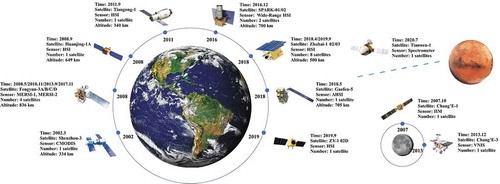With the maturation of satellite technology, Hyperspectral Remote Sensing (HRS) platforms have developed from the initial ground-based and airborne platforms into spaceborne platforms, which greatly promotes the civil application of HRS imagery in the fields of agriculture, forestry, and environmental monitoring. China is playing an important role in this evolution, especially in recent years, with the successful launch and operation of a series of civil hyperspectral spacecraft and satellites, including the Shenzhou-3 spacecraft, the Gaofen-5 satellite, the SPARK satellite, the Zhuhai-1 satellite network for environmental and resources monitoring, the FengYun series of satellites for meteorological observation, and the Chang’E series of spacecraft for planetary exploration. The Chinese spaceborne HRS platforms have various new characteristics, such as the wide swath width, high spatial resolution, wide spectral range, hyperspectral satellite networks, and microsatellites. This paper focuses on the recent progress in Chinese spaceborne HRS, from the aspects of the typical satellite systems, the data processing, and the applications. In addition, the future development trends of HRS in China are also discussed and analyzed.

The development history of the spaceborne HRS sensors in China
https://www.tandfonline.com/doi/full/10.1080/10095020.2020.1860653


